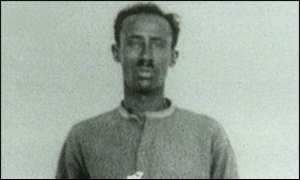With the newspapers dominated by chaos and increasing threats from air raids, a Grangetown man became in August 1940 the last Cardiff murderer to be hanged at the city’s prison.
Three other men from outside the city would be executed there afterwards. Then there would be one final hanging – a terrible miscarriage of justice, when the unfortunate Mahmood Hussein Mattan was sentenced to death in 1952.

But the Somalian former merchant seaman (above) was wrongly convicted and was finally post-humously pardoned in 1998.
The execution of George Edward Roberts, like the preceding murder trial, passed relatively unnoticed by the public, distracted by World War Two headlines.
The 29-year-old labourer – employed making air raid shelters – lived with his wife Agnes, 27, in a shared house at 54 Kent Street.
On the night of Saturday 3rd February 1940 he had been at a party in Ferry Road, where he met Arthur John Allen, 30, a Merchant Navy senior steward on the steamer Houston City. The party was to celebrate a fellow crew member’s engagement.
The story goes that the men struck up a conversation and at 2.30am, Allen, who had £5 in notes on him, was after change for the phone box to call a cab to take him back to his home at 121 Clive Road in Canton.
Roberts offered to help him – and invited him back to his house.
But instead, at some point, he stole Allen’s cash – and then back at the house he subjected him to a “unprovoked and brutal attack” with an iron bar.
Roberts then dragged Allen – semi-conscious with a fractured skull – to Grangetown police station at 4.30am, where, calling himself “Smith” he told officers he had stumbled across Allen lying in Bradford Street.
At the same time, a woman at the police station, Margaret Clifford, was reporting hearing bangs and a commotion at 54 Kent Street.
At the time, the fire service was under the control of the police force and a fireman happened to be at Grangetown police station.
Roberts asked him for a cigarette. The fireman would later tell police he found five pound notes folded up in the packet after it was returned to him.
At Roberts’s home back in Kent Street, police found blood stains, hairs on the iron bar which matched the victim, and an empty wallet on the mantelpiece. He was charged with assault and robbery with violence.
A 16-year-old milk delivery boy found a blood-stained jacket and coat, which contained Allen’s name on documents in the pockets.
The seriously injured Allen was a patient in Cardiff Royal Infirmary. He regained consciousness enough for a special sitting of magistrates in late March. Sitting in a hospital chair, Allen remembered Roberts offering him tea but little else of what happened until his head was being stitched by a doctor at the city’s Lodge hospital.
On 28th March, Allen was operated on by Professor Lambert Rogers, who found extensive head injuries and a compressed fracture was exposed. He removed fragments of the skull and Allen started to improve.
But on 3rd April he took a turn for the worse and became “decidedly weaker” over the course of the next few days. On 9th April, just after 9am, Allen died. The coroner recorded he died of a brain abcess and septic meningitis from a fractured skull.
Roberts was charged with murder.
He insisted at his trial that he acted in self-defence and that he knew that Allen “would get the better of him” – claiming he was hit violently in the stomach and chest, as Allen demanded to know where his money was. Roberts claimed he only picked up the iron bar to frighten him.
But the post mortem examination revealed he suffered several blows to the head.
Roberts was found guilty and Mr Justice Macnaghten passed sentence at Swansea Assizes on July 17th.
The South Wales Echo reported on the morning of the execution on August 8th that “there was little to indicate that inside a man was taking the short walk from the cell to the scaffold that was to lead to eternity.”
Describing the scene outside Cardiff Prison in Knox Road, the reporter wrote: “One or two women, men on their way to work, a few pressmen and two uniformed policemen, were the only ones to stand silently by as the fatal hour approached. A woman in a green coat dropped to her knees and said a silent prayer.”
The “deadly silence” was broken only by the sobbing of women. After 9am, a notice was posted at the prison entrance.
The sentence was carried out – veteran executioner Thomas Pierrepont was still employed because there was no suitable replacement – “without a hitch,” according to the governor Frank Cecil Ransley. Dr Thomas Wallace was also present. Death was instantaneous.
Roberts, born in Dudley Street, the fifth child in a large Docks family. He had married Agnes Ennis in 1932, the daughter of a local mariner and they had four children, the youngest born after his death. Agnes remarried after the war.
Photo of Cardiff Prison – By Richard Sutcliffe, CC BY-SA 2.0, https://commons.wikimedia.org/w/index.php?curid=53568541
- Steve is hoping to publish Cardiff and The Blitz in the near future – the stories of tragedy and courage behind the air raids on the city.
Thanks Steve. An interesting and sad piece of Cardiff history. Nicely researched.
LikeLike